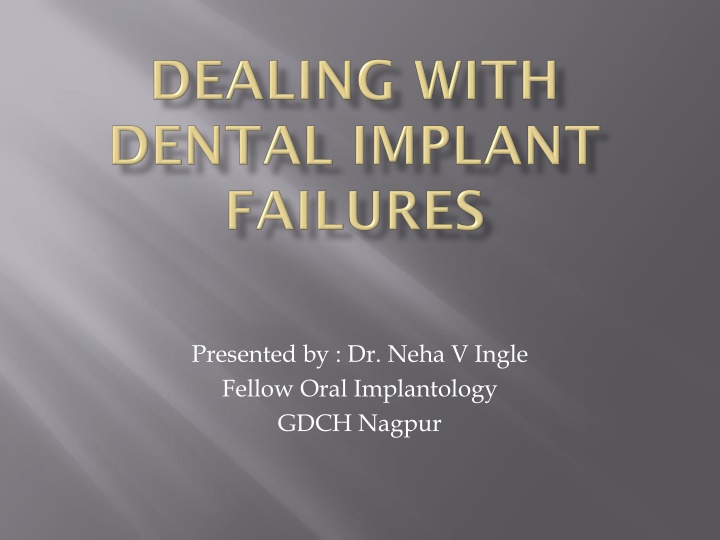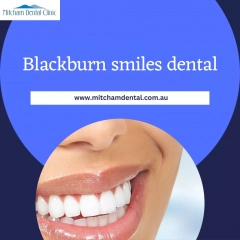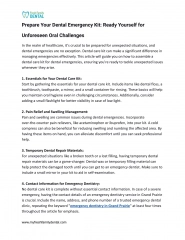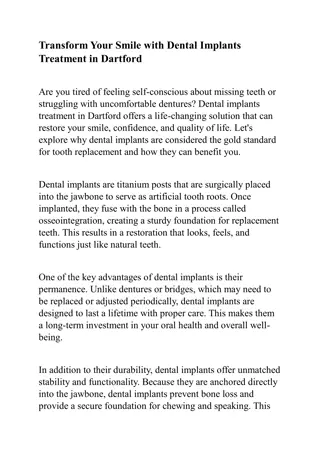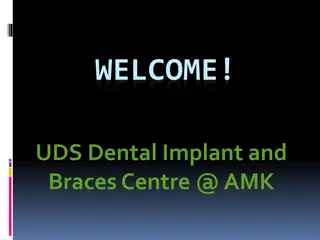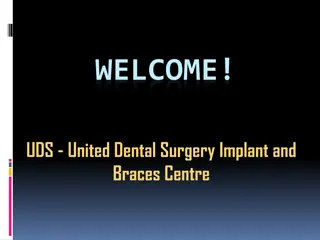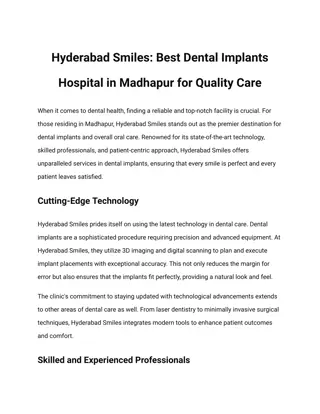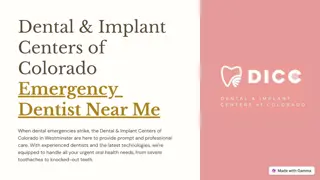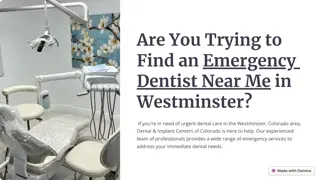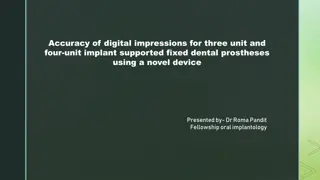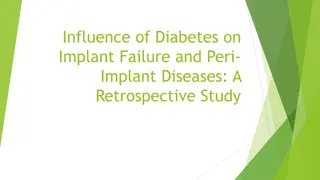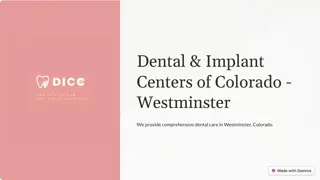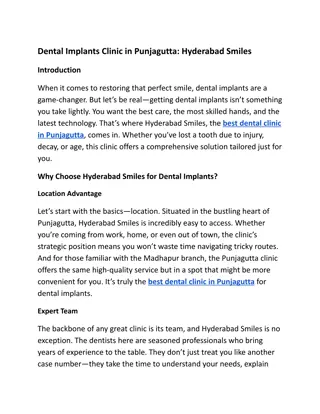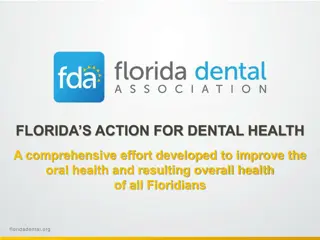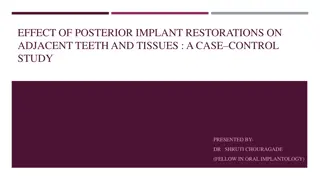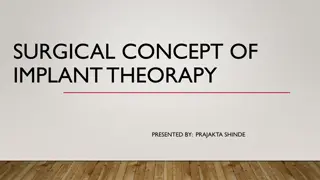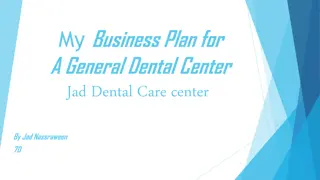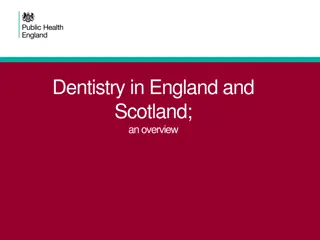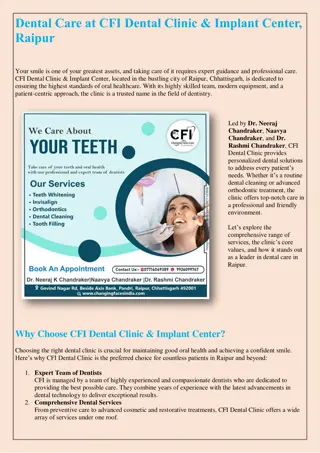Methods for Dental Implant Failure
An implant-supported restoration offers a predictable solution for tooth replacement, with high success rates. This paper describes various methods to address dental implant failure, including predictors for success and failure, criteria for implant survival, and follow-up recommendations.
Download Presentation

Please find below an Image/Link to download the presentation.
The content on the website is provided AS IS for your information and personal use only. It may not be sold, licensed, or shared on other websites without obtaining consent from the author.If you encounter any issues during the download, it is possible that the publisher has removed the file from their server.
You are allowed to download the files provided on this website for personal or commercial use, subject to the condition that they are used lawfully. All files are the property of their respective owners.
The content on the website is provided AS IS for your information and personal use only. It may not be sold, licensed, or shared on other websites without obtaining consent from the author.
E N D
Presentation Transcript
Presented by : Dr. Neha V Ingle Fellow Oral Implantology GDCH Nagpur
Authors : 1DMD, Department of Oral Rehabilitation, The Maurice and Gabriela Goldschleger School of Dental Medicine, Tel Aviv University, Tel Aviv, and Periodontology Unit, Department of Oral & Dental Sciences, Rambam Medical Center, Haifa, Israel Sources : J Appl Oral Sci. 2008 Jun;
An implant-supported restoration offers a predictable treatment for tooth replacement. Reported success rates for dental implants are high. The aim of this paper is to describe different methods and treatment modalities to deal with dental implant failure.
An implant-supported restoration offers a predictable treatment for tooth replacement. Reported success rates for dental implants are high, however, there is still a paucity of data in the literature regarding follow-up of implants in function for at least 5 years or more
Reported predictors for implant success and failure are generally divided into patient-related factors (e.g., general patient health status, smoking habits, quantity and quality of bone, oral hygiene maintenance, etc), implant characteristics (e.g., dimensions, coating, loading, etc), implant location, and clinician experience.
Success of dental implants is commonly defined by implant survival. Ongoing marginal bone loss (MBL) could also put at risk implant survival in the long-term. In 1986, Albrektsson, et al. suggested success criteria for MBL, among other parameters.
During the first year after abutment connection, 1 mm of MBL is allowed followed by 0.2 mm per year. Today, these criteria are still frequently referred to as the "gold standard" for implant success.
An implant that causes clinical symptoms, such as continuous pain, mobility, etc, is considered faulty. However, MBL is rarely symptomatic but may endanger long-term implant survival. Long-term prognosis of an implant cannot be established based only on first year MBL calculations.
Recommended that four clinically detectable MBL patterns be used for clinical follow-up and assessment. These hypothetical patterns of implant MBL after the first year were low rate MBL over the years (Albrektsson's pattern) low rate MBL in the first few years followed by a rapid loss of bone support. high rate MBL in the first few years followed by almost no bone loss continuous high rate MBL leading to complete loss of bone support (For review see Schwartz-Arad, et al.).
Criteria for implant success should serve as an aid to clinical follow-up and to help evaluate the clinical outcomes of different implant systems in research. For clinical use, MBL assessment should be easy to apply using radiographs and should allow a quick gross comparison to previous data.
With Albrektsson's clinical parameters, it should help the clinician assess a given condition and predict its future clinical course, as well as help in decision making regarding additional tests/therapy (i.e., radiographs, occlussal analysis, prosthetic evaluation, surgical intervention, etc), frequency of follow-up, and hygiene appointments.
In a low MBL rate during the first 3 years, the MBL pattern is still undetermined in an asymptomatic implant. Frequent follow-up is recommended to decide whether the implant is failing. Nevertheless, long-term follow-up is suggested for all MBL patterns.
The success of implants replacing failed ones at the exact site has been reported. Using the commercially pure titanium screw-shaped implants, it has been suggested that when an implant is lost, a flap should primarily cover the entrance to the site and after 9-12 months, a new implant can be replaced at that site.
They suggest that a 1- year healing period may not be necessary provided the socket can be prepared to eliminate thread grooves and invasive soft tissue; the implant replacement is larger in diameter than the original implant; and sufficient available bone remains for the procedures.
The 29 machined-surface implants replaced by implants with the same surface, 6 failed (79.4% survival rate) compared to the 19 machined- surface implants replaced by TiUnite surface implants where only 1 failed. Of the 10 TiUnite-surface implants replaced by implants with the same surface, none failed. In a study that assessed survival and success rates of single dental implants replacing a previously failed implant at the same location, an overall survival rate of 71% was reported with a mean follow-up of 19.4 11.4 months.
Meticulous removal of granulation tissue on the failed implant site and the use of wider implants with improved surfaces could improve the outcome of re-implantation. An implant that replaces a previously failed one could serve as a predictable procedure with reasonable survival rates.
Short arch When planning implant rehabilitation or when facing implant failure, one should always refer to the question: How many teeth are necessary for adequate function or what dentition assures oral function? In 1992, the World Health Organization (WHO) stated that throughout life, the retention of a functional, esthetic, natural dentition of 20 teeth, without requiring prostheses, should be the treatment goal for oral health.
After extensive review of the literature, Elias andSheiham concluded that to satisfy oral functional needs a complete dentition is not necessary, which is in accordance with others who suggest that middle-aged and older adults have sufficient oral function with 20 natural teeth, and question the need to replace missing molars.
FIXED PARTIAL DENTURE : The alternative use of fixed partial denture (FPD), if applicable, is another treatment modality. Recently, a thorough systematic review was conducted that analyzed and compared the survival and success rates of different designs of tooth and implant-supported fixed reconstructions and assessed the incidence of biological and technical complications of FPDs and dental implants. The incidence of technical complications was significantly higher for the implant-supported reconstructions compared with tooth-supported FPDs.
Tooth longevity is largely dependent on the health status of the periodontium, pulp or periapical region, and extent of reconstructions. Multiple risks lead to a critical appraisal of the value of a tooth.
REMOVABLE DENTURE : Removable partial dentures (RPDs) are still extensively used for the restoration of partially edentulous patients. However, these prostheses have been associated with poor patient acceptance, compromised function and esthetics, and increased risk for caries and periodontal disease. Clinicians and dental educators have debated the necessity of using and teaching removable prosthodontics for the partially edentulous patient in today's implant era. Some even consider the art of removable prosthodontics as obsolete.
Despite the obvious need for RPDs, a detailed search of the dental literature failed to elicit strong evidence- based indications for treating the partially edentolous patient with a conventional clasp-retained RPD. When implants fail or are not an option and economic considerations preclude extensive fixed restorations, RPDs are a valid treatment alternative.
Implant tooth-supported removable partial denture (RPD) Implants are used to improve the RPD support, enhance retention and stability, preserve the residual ridge underneath the denture base, reduce the stress applied on the abutment teeth, eliminate the need for un-esthetic clasp assemblies, and modify unfavorable arch configurations.
Laboratory and clinical studies show the effectiveness of implant-supported RPDs. distally-placed implants supporting a mandibular Kennedy Class I RPDs prevented displacement of the distal extension implant-supported RPDs, improved occlusal support, and decreased the pressure on soft tissues compared to conventional RPDs.
In a retrospective clinical study, 10 patients were treated with uni- and bi-lateral mandibular distal- extension RPDs supported by 16 posterior implants. Implants were used as either vertical stops to enhance the prosthesis support or with resilient retentive elements. There was consistently increased satisfaction in all patients, minimal component wear, no radiographic evidence of excessive bone loss around the implants, and stable peri-implant soft tissues.
23 implant-supported RPD were placed in 44 implants during a 10-year period (1996-2005). Maxillary restorations were provided to 13 patients and mandibular to 10 patients. Before implant placement, the most prevalent arch configuration was Kennedy Class I in the maxilla (6 patients) followed by Kennedy Class II in the mandible (4 patients). Arch configuration was modified by implant placement in 6 (26.1%) patients.
Survival rate was 95.5%; only two implants did not survive, both in a heavy smoker with pre-existing periodontal disease. During follow-up, only one abutment tooth was lost. All other abutments remained in function with no need for re-treatment during the last recall.
All patients were highly satisfied with the restoration. According to our findings, we suggest that implant- supported RPD could serve as a long-term predictable treatment modality. Nevertheless, a long-term multi- center study is recommended to evaluate the success of this treatment modality in a larger patient sample. Prospective clinical studies should focus on abutment longevity and need for prosthesis maintenance.
Implant therapy has become common practice and will probably gain in popularity during the next several years. This implies that dental professionals will have to deal more with implant failure and related complications. When an implant fails, a tailor made treatment plan should be provided to each patient according to all relevant variables. Patients should be informed regarding all possible treatment modalities after implant failure and give their consent to the most appropriate treatment option for them.
Adell R, Lekholm U, Rockler B, Brnemark P-I. A 15-year study of osseointegrated implants in the treatment of the edentulous jaw. Int J Oral Surg. 1981;10:387 416. [PubMed] [Google Scholar] 2. Albrektsson T, Zarb G, Worthington P, Eriksson AR. The long term efficacy of currently used dental implants: a review and proposed criteria of success. Int J Oral Maxillofac Implants. 1986;1:11 25. [PubMed] [Google Scholar] 3. Alsaadi G, Quirynen M, van Steenberghe D. The importance of implant surface characteristics in the replacement of failed implants. Int J Oral Maxillofac Implants. 2006;21:270 274. [PubMed] [Google Scholar] 4. Armellini D, von Frauenhofer JA. The shortened dental arch: a review of the literature. J Prosthet Dent. 2004;92:531 535. [PubMed] [Google Scholar] 5. Beltran-Aguilar ED, Barker LK, Canto MT, Dye BA, Gooch BF, Griffin SO, et al. Surveillance for dental caries, dental sealants, tooth retention, edentulism, and enamel fluorosis United States, 1988-1994 and 1999- 2002. MMWR Surveill Summ. 2005;54:1 43. [PubMed] [Google Scholar]
THANK YOU
